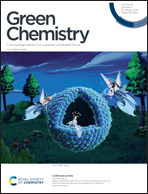Fouling is the beginning: upcycling biopolymer-fouled substrates for fabricating high-permeance thin-film composite polyamide membranes†
Abstract
The recycling of end-of-life water purification membranes is of great significance for environmental sustainability. However, only techniques for downcycling end-of-life high-pressure membranes are available. Here, we propose to upcycle fouled microfiltration membranes for fabricating new high-pressure polyamide (PA) thin-film composite membranes via interfacial polymerization (IP). A cross-linked, defect-free, and ultrathin PA active layer was formed on biopolymer-fouled substrates. In contrast to the decreased pure water permeance of substrates caused by biopolymer fouling, the upcycled membranes show excellent water permeance (∼30 L m−2 h−1 bar−1) and Na2SO4 rejection (∼95%) in nanofiltration tests for water purification. The biopolymer foulants regulate the IP process and the formation of the PA layer. Furthermore, the foulants between the PA layer and substrate can create additional channels for water transport. The PA layer formation could also be achieved on real fouled microfiltration substrates. This proof-of-concept study paves the way for upcycling fouled/end-of-life low-pressure membranes to fabricate new high-pressure membranes for water purification, forming a closed eco-loop of membrane recycling.



 Please wait while we load your content...
Please wait while we load your content...